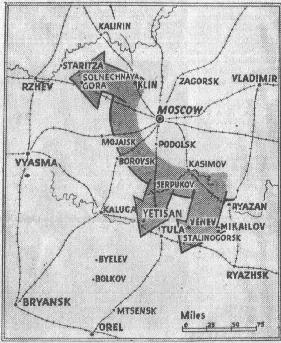|

Daily Sketch, Saturday, December 13, 1941
Russians Smash German Army Before Moscow
85,000 Nazis Die: 1,434 tanks, 5,416 Lorries Lost
THE RUSSIAN ARMY, SMASHING THE LAST GERMAN ATTEMPT TO TAKE MOSCOW, HAS RECAPTURED EIGHT TOWNS. THEY ARE:
 STALINOGORSK, 120 miles S.E. of Moscow.
STALINOGORSK, 120 miles S.E. of Moscow.
SOLNECHAYA GORA, 40 miles N.W. of Moscow.
ROGACHEV, N.W. of Moscow, near Klin.
YAKHROMA, near Klin.
VENEV, 30 miles N.E. of Tula.
KISTRA, in Tula region.
MIKAILOW, 60 miles east of Tula.
YETISAN, west of Venev.
Klin, key town 50 miles north-west of Moscow, is surrounded and the Russians actually have by-passed it on the south-west.
In operations from November 16 to December 10, says the special communiqué from Kuibishev last night, the Germans, according to incomplete reports, had lost 85,000 men killed , while these quantities of arms and materials had been either captured or destroyed:
Some 1,434 tanks, 5,416 vehicles with troops and supplies, 575 guns, 399 minethrowers, 870 machine-guns and great quantities of other materials. "The exact figures cannot be given because operations are still in progress," said Moscow radio.
Fleeing Germans Poison Food
From the time the Russians took the offensive on December 6, 30,000 Germans were killed and 557 tanks, 397 guns and 4,882 vehicles were captured or destroyed.
Pursuing the Germans at Klin, the Russians are now southwest of the town.
In their flight the Germans are burning villages and poisoning food they cannot take with them.
General Lilushenko smashed the first tank division, the 14th and 36th motorised infantry divisions and, in capturing Rogachev, surrounded Klin.
Here is the communiqué describing operation from November 16 when the Germans began their second great offensive, up to last Wednesday:
"On November 16, the following German troops took up positions on our Western front: the 13th Tank Division, the 33rd Infantry division and five infantry divisions.
Thus began the second great offensive against Moscow.
The enemy's aim was to encircle and occupy Moscow in a pincer movement and at the same time to drive wedges into our flank.
His task was to occupy Moscow, advancing from Tula, Kashira and Riazan and Kolomna, from Klin, Solnechnaya Gora, Rogechev, Yakrofa and Dmitrow, striking against Moscow from three sides.
For this he concentrated against our right flank in Klin, Solnechnaya Gora and Dmitrov directions the third and fourth tank groups of German generals Belitch and Schuchner, consisting of the first, second, fifth, sixth, seventh, tenth and eleventh tank divisions, the 36th and 14th motorised infantry divisions, and the 23rd, 106th and 35th infantry divisions.
Against our left flank, in the Tula, Kashira and Ryazan directions, he concentrated the second mechanised army of General Guderian.
Against our centre, he concentrated the 9th, 7th, 20th, 12th, 13th and 32nd army corps, and the 19th and 20th tank divisions.
On December 6, our troops having worn down the enemy, launched counter offensives against his flanks.
As a result of this offensive, both the enemy flank groups have been routed and are rapidly retreating, leaving behind arms and equipment and suffering heavy losses."
Describing the battle up to the time the Russians took the offensive on December 6, the communiqué said:
"Two enemy army groups trying to capture and occupy Moscow from three sides were repulsed with heavy losses.
According to incomplete data, and not counting enemy aircraft, Russian troops have destroyed or captured 777 German tanks, 534 lorries, 187 guns, 119 trench mortars, and 224 machine-guns in the whole sector.
The enemy lost 55,170 men."
The communiqué then went on to list the successes gained and review the position as it stood yesterday.
General Kuznetsov captured Yakhroma, pursuing the German sixth and seventh tank divisions and the 23rd infantry division.
The victor at Stalinogorsk and Venev is General Balov.
The 5th, 10th and 11th Tank Divisions are being pursued by General Rokossovsky, who took Kistra.
To the north-west of Tula, General Bodin's forces, having routed the 3rd and 4th Tank Divisions and an S.S. regiment of the Germania Division, are successfully developing their offensive, pressing on and surrounding the 296th Infantry Division.
Since the beginning of the Russian offensive on December 6, Moscow radio stated, more than 400 villages had been cleared of the enemy on the Moscow front.
BACK
Copyright © 2001 World War II Newspapers. All rights reserved.
|

 STALINOGORSK, 120 miles S.E. of Moscow.
STALINOGORSK, 120 miles S.E. of Moscow.